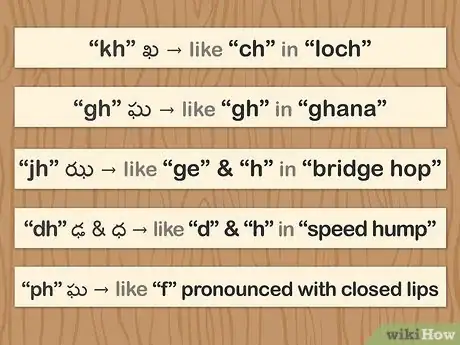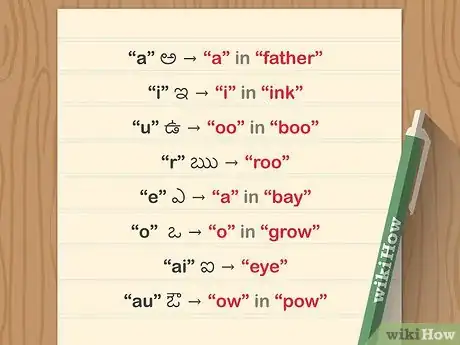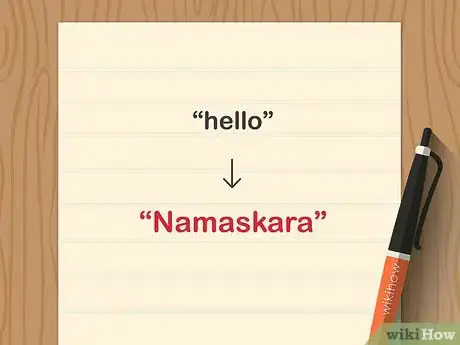This article was co-authored by Tian Zhou and by wikiHow staff writer, Jennifer Mueller, JD. Tian Zhou is a Language Specialist and the Founder of Sishu Mandarin, a Chinese Language School in the New York metropolitan area. Tian holds a Bachelor's Degree in Teaching Chinese as a Foreign Language (CFL) from Sun Yat-sen University and a Master of Arts in Teaching English to Speakers of Other Languages (TESOL) from New York University. Tian also holds a certification in Foreign Language (&ESL) - Mandarin (7-12) from New York State and certifications in Test for English Majors and Putonghua Proficiency Test from The Ministry of Education of the People's Republic of China. He is the host of MandarinPod, an advanced Chinese language learning podcast.
This article has been viewed 91,563 times.
Bangalore has grown to become the IT capital of India, with immigrants making up nearly half of its population. With this influx of immigrants, interest in learning Kannada, the local language, has grown. Whether you're a recent immigrant to Bangalore or simply want to learn the language to converse with people from the region, in 2019 it is easier than ever to learn Kannada. Start with your pronunciation, then learn some basic vocabulary so you can communicate with native speakers. Your vocabulary and understanding will grow further if you immerse yourself in the language.[1]
Steps
Mastering Pronunciation
-
1Become familiar with the Kannada alphabet. If you start with the alphabet, you will know how words are pronounced and be able to sound out unfamiliar words, even if you aren't sure what they mean. This can be a big help as you're trying to learn the language, especially if you want to ask a native speaker what a word means.[2]
- The website Omniglot has a chart with the Kannada alphabet that you can download and use to practice. Go to https://www.omniglot.com/writing/kannada.htm and click the link to download the chart.
- To memorize the alphabet, choose 4 or 5 letters each day and practice until you've got the hang of them. The next day, go back and practice the letters you already know, then try to pick up another 4 or 5 letters. Follow this pattern until you know the whole alphabet.
- Kannada is written from left to right in horizontal lines, just like English.
Tip: The Kannada alphabet is an alphasyllabary, meaning each consonant has an inherent vowel. These vowels are indicated by marks appearing above, below, before, or after the consonant. Vowels are only written as independent letters if they fall at the beginning of a syllable.
-
2Start with consonants that are pronounced the same as they are in English. Most of the consonant sounds in Kannada are pronounced roughly the same way as their counterparts in English, although the script is tremendously different. However, if you're just working on speaking the language, you can start with a transliterated version of words and phrases that uses an alphabet similar to the English alphabet.[3]
- The "c" in Kannada, చ, is only pronounced like the hard English "c" in the word "cat." There is no soft version of this letter as there is in English.
- The "j" in Kannada, జ, is pronounced with a "zh" sound, like the "s" in the English word "vision."
- Remember that the marks you see above, below, before, or after a consonant in Kannada script indicate the inherent vowel sound. The consonant sound itself remains the same.
Tip: While most of the consonants have roughly the same sound as the corresponding consonant in English, the sounds are often not equivalent because the sound is made with a different part of your mouth. The best way to get your pronunciation right is to mimic native speakers.
Advertisement -
3Practice double consonants. In addition to the individual consonants, Kannada has 6 double consonants. For the most part, these aren't pronounced the way you'd expect the same combination of letters to be pronounced in English. However, there are near-equivalents that you can use to practice.[4]
- The "kh" sound, ఖ, sounds similar to the "ch" in the Scottish word "loch" or the "ch" sound in German.
- The "gh" sound, ఘ, sounds similar to the "gh" in the name of the country "Ghana."
- The "jh" sound, ఝ, sounds similar to the "ge" and "h" sounds in the English phrase "bridge hop."
- The "dh" sound, ఢ and ధ, sounds similar to the "d" and "h" sounds in the English phrase "speed hump."
- The "bh" sound, భ, sounds similar to the "b" and "h" sounds that occur in the middle of the English phrase "bulb holder."
- For the "ph" sound, ఫ, say each consonant individually. It sounds like the "p" as in "puff" followed by a short puff of air. To get it right, say the syllables "pa" and "ha," gradually saying them faster and faster until the first vowel sound disappears.
-
4Work on pronouncing the correct vowel sounds. There are 16 vowels in Kannada. With the exception of two blended vowels, each of these vowels has a short and long version. For the longer version, you simply hold the sound out longer than you would to pronounce the short version.[5]
- The "a" sound, ಅ, sounds like the "a" in the English word "father."
- The "i" sound, ఇ, sounds like the "i" in the English word "ink."
- The "u" sound, ఉ, sounds like the "oo" in the English word "boo."
- The "r" sound, ఋ, sounds like "roo," although the "r" sound is slightly trilled. There is no equivalent to this vowel sound in the English language, so you'll just have to practice.
- The "e" sound, ఎ, sounds like the "a" in the English word "bay."
- The "o" sound, ఒ, sounds like the "o" in the English word "grow."
- The "ai" sound, ఐ, sounds like the English word "eye."
- The "au" sound, ఔ, sounds like the "ow" in the English word "pow."
Having Basic Conversations
-
1Greet people by saying "Namaskara." "Namaskara" is the basic Kannada version of the English "hello," and is suitable to greet people in any setting. You can also use "namaste" (nah-mah-stay), a greeting that is universally understood throughout India.
- After you say "hello" to someone, if you plan on having any further conversation with them, you'll typically ask them how they're doing. In Kannada, you would say "Neevu hegidheera?" If another person asks the same of you, say "chennagidhene dhanyavadagalu," which means "fine, thank you."
-
2Vary your greeting depending on the time of day. As in other languages, when speaking Kannada, you aren't limited to "hello." If you want to vary your greeting, use a greeting that emphasizes whether it is morning, afternoon, or evening using the following phrases:[6]
- Shubhodaya (good morning)
- Shubha madhyahna (good afternoon)
- Shubha saayankaala (good evening)
-
3Introduce yourself by saying "Nanna hesaru" followed by your name. Before you start a conversation with somebody, it's a good idea to tell them who you are. "Nanna hesaru" means "my name is" in Kannada.
- You can follow with "nimma hesaru yenu," which means "what is your name?"
- After the person tells you their name, you might say "nimannu beti madi santoshavatithu," which means "pleased to meet you" or "happy to meet you."
-
4Pick up basic question words. Even if you don't understand everything someone is asking you in Kannada, you may be able to get a general idea if you recognize the basic question words. Then you'll at least understand what type of question they're asking, and you might be able to infer the rest from context. The basic question words in Kannada are:[7]
- Yaaru (who)
- Yaake (why)
- Yaavaga (when)
- Elli (where)
- Enu (which)
- Hege (how)
-
5Use polite and respectful words with people when you talk to them. As in any culture, being polite and respectful will endear you to strangers. People will also be more willing to help you with your speaking skills and be more patient with your halting Kannada if you mind your manners when talking to them. Some polite words and phrases to remember include:[8]
- Kshamisi (sorry/excuse me)
- Dayavittu (please)
- Dhanyavaada (thank you)
- parwagilla bidi (you're welcome)
Tip: When speaking with strangers, especially those older than you, use the plural form of the second-person pronoun, neevu, to indicate politeness and respect.
Immersing Yourself in the Language
-
1Watch Kannada movies with subtitles. With Kannadiga films, you have an opportunity to hear people having natural dialogue in the language. Turning on English subtitles will help you understand what's going on and what the characters are saying. If you want to learn the script, you can turn on subtitles in Kannada script so you can hear the words being spoken.[9]
- Avoid using English subtitles as a crutch. Remember that translation is an interpretation of the meaning of the words, not literally what the characters are saying.
- Even if you pick up some new phrases from a movie, be cautious about the context in which you use them until you understand the full meaning of the phrase.
-
2Check out the news in Kannada. If you live in Bangalore, you can find news programs on tv and the internet in Kannada. Not only can these programs help you learn the language, but they can also help you stay informed about events happening in your city.[10]
- If you see coverage of an event that you already know about, you can use your understanding of the situation to improve your listening or reading comprehension.
-
3Listen to Kannada radio stations. In and around Bangalore, you should be able to pick up radio stations broadcasting in Kannada and playing Kannadiga music. The repetition of music lyrics is a good way to learn a language.[11]
- Listening to Kannadiga music also gives you some insight into the values and culture of the native people of the area.
-
4Speak Kannada with native speakers at every opportunity. You might ask "neevu kannada maataadteera?" This means "Do you speak Kannada?" If they say "howdhu" (yes), continue to speak to them in Kannada, even if they reply in another language.[12]
- The best way to become fluent is to immerse yourself in the environment of the target language.
- If you live in Bangalore, you may find that local Kannadigas are more inhibited about speaking Kannada in public and may be reluctant to converse with you in their native language. However, if you let them know that you're interested in learning the language, they might become more open.[13]
Tip: Even if the person insists on speaking to you in English, their answers in English can let you know if they understood what you said in Kannada. This can be an immense help to you as a student of the language.
References
- ↑ http://bengaluru.citizenmatters.in/learning-kannada-now-a-cool-trend-in-bangalore-5519
- ↑ https://www.omniglot.com/writing/kannada.htm
- ↑ http://learn101.org/kannada_alphabet.php
- ↑ http://learn101.org/kannada_alphabet.php
- ↑ https://www.omniglot.com/writing/kannada.htm
- ↑ https://www.omniglot.com/language/phrases/kannada.php
- ↑ http://bengaluru.citizenmatters.in/how-to-learn-kannada-bangalore-kannada-classes-online-5523
- ↑ https://www.omniglot.com/language/phrases/kannada.php
- ↑ http://bengaluru.citizenmatters.in/how-to-learn-kannada-bangalore-kannada-classes-online-5523
- ↑ http://bengaluru.citizenmatters.in/how-to-learn-kannada-bangalore-kannada-classes-online-5523
- ↑ http://bengaluru.citizenmatters.in/how-to-learn-kannada-bangalore-kannada-classes-online-5523
- ↑ https://www.omniglot.com/language/phrases/kannada.php
- ↑ http://bengaluru.citizenmatters.in/learning-kannada-now-a-cool-trend-in-bangalore-5519
- ↑ http://ccat.sas.upenn.edu/plc/kannada/








































































